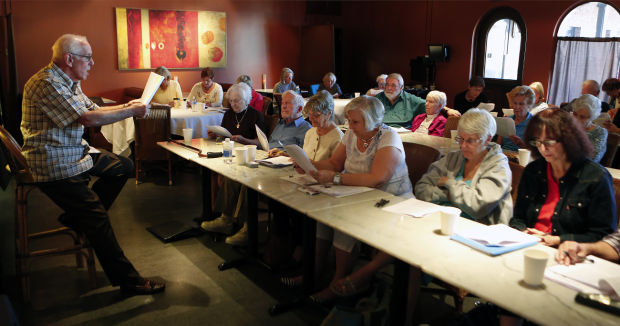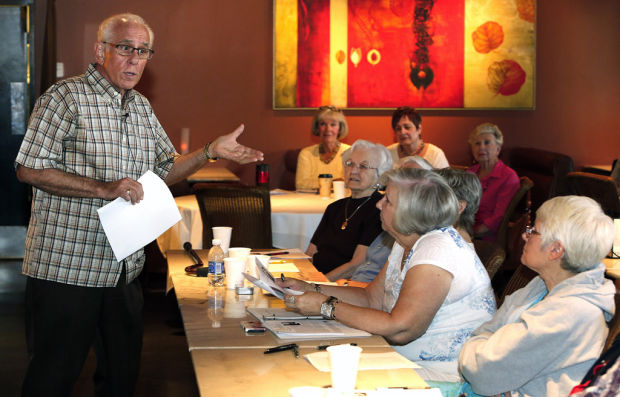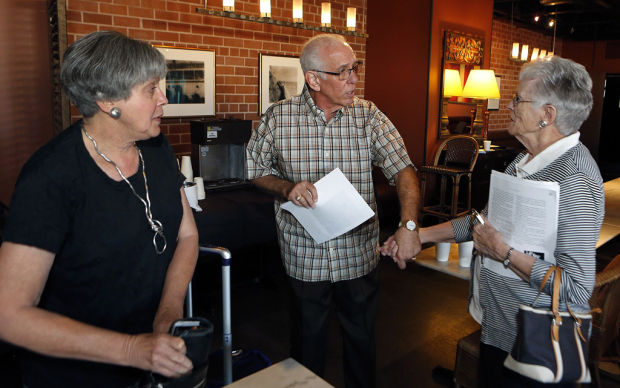If ever there comes a day when Bill Fry cannot stand in front of his Learning Curve class, his students promise to wheel him in.
Fry teaches literature courses for the 12-year-old, noncredit, adult education program, The Learning Curve. A founding faculty member, Fry, 73, began lecturing for the program in 2002, shortly after moving to Tucson from Washington, D.C., with his life partner, Raymond F. Thompson Jr.
Unlike the undergraduates and high school students Fry taught for about 40 years, Learning Curve students do not come to class just to get a study guide for the test — in fact, there are no tests or homework. Instead, these students come to soak in knowledge, relishing a community of like-minded scholars.
“We have older students who come to us with a great deal of life experience, and they bring that experience into the discussion, and they’re not intimidated,” Fry said. “These people are passionate about learning, and the instructors are passionate about teaching. I really do believe it is the most important thing in my life, teaching, and specifically, teaching for The Learning Curve.”
The Learning Curve began with Susan Dick, the current director. As a program coordinator for the University of Arizona’s noncredit Extended University in the 1990s, Dick discovered the value of lifelong learning — particularly in the arts and humanities. When the UA program shifted its emphasis to include business-oriented classes, Dick left in 2001. Not long after, she started receiving nudges from students and faculty members. They encouraged Dick to start an independent arts and humanities program.
“People who love Tucson tend to appreciate the arts and humanities and what we have to offer here,” Dick, 63, said. “The symphony, theater, the opera started here. We have a real heart for the arts in Tucson.”
Tucson’s big heart aside, Dick started small, keeping her day job with the Tucson Symphony Orchestra. In the fall of 2002, The Learning Curve offered about a dozen noncredit courses taught by university professors, local artists and musicians and community experts.
“The phone didn’t stop ringing,” Dick said.
Now, The Learning Curve gets around 2,000 registrations a year for about 30 courses. Most students are older than 50. They sign up to study European history or learn to paint. Last spring, the encore to a course on Broadway took a small group of students to the Big Apple itself. The emphasis remains on the arts and humanities, but the Learning Curve also responds to the needs of its students.
Now, some can sign up for iPad tutorials and similar technology courses taught by John Nemerovski, 65. They learn to check traffic in the maps app and find wi-fi on the go.
Jean Lewis, 66, has taken the course so many times, she now helps Nemerovski, adding the tech class to her list of Learning Curve experiences.
“A lot of the things are things I can use in my life,” Lewis said. “The more I learn, the more I can understand it.”
When Lewis and her husband took a trip to England four years ago, they spent the year prior in Learning Curve courses, absorbing English history.
“We would be traveling around and say, ‘You remember King So-and-so? Well, look! Here is where he was murdered,’” Lewis said. “I’m making this a little extreme, but we definitely had enough knowledge that we kind of got it and were able to relate a little bit more to the places we visited and understand the history and culture.”
Although Learning Curve courses stay rooted in academia, many instructors choose to add creative flair to the presentation of their content, exploring everything from the food of ancient Egypt to the nuances of children’s literature. They attract snowbirds and retired seniors looking for activity and community.
Students enroll for a variety of reasons. Some pick classes by topic or to meet personal interests and needs. Others follow instructors, enthralled by lecturers who double as storytellers. Lewis and her husband still take English history courses from a UA professor emeritus, Richard Cosgrove.
Fry, another instructor with a fan base, has seen his followers become friends. He has about 40 students who have taken every course he has taught with The Learning Curve.
“When class is over, they hang around, and we go to lunch,” Fry said. “Every week, I go to lunch with a different group. Those friendships develop not just between them and me, but between each other.”
Like many Learning Curve students, Ann Jensen, 75, retired in Tucson. A former lawyer, Jensen’s move to Tucson came, in part, from a desire to connect with the creative side of her brain. In The Learning Curve, she found more than an artistic outlet — she found friendships.
In Fry’s first class, Jensen met several women who would become her “very best friends in Tucson.” They go to the symphony and movies together, and Jensen has them over for breakfast. They talk frequently.
“It’s a connection that goes beyond the learning aspect of it,” Jensen said.
For Fry, that decades-old community stepped up when his life partner, Thompson, died in April. When Fry organized a celebration of Thompson’s life, about 260 people attended. He suspects that more than 100 of those individuals came in connection with The Learning Curve.
“Those people sustained me,” Fry said. “They are my friends. They were our friends.”
A lifelong academic and a former literature professor, Thompson attended the occasional lecture and often joined Fry for lunch after his classes. When Thompson accompanied Fry to his initial interview with Dick in 2001, she tried to recruit him and would continue to do so throughout the years.
“She said, ‘I have a place for you, too.’ And Ray said, “No, no, no! I came here to garden. I didn’t come here to work!’” Fry said. “Susan and I still laugh about that.”
The no-pressure attitude in Learning Curve classes enriches both the academics and the relationships, benefiting students and teachers. Students don’t stress about tests, and teachers don’t worry about grading. The Learning Curve keeps a community of mostly retired adults thinking and engaged.
“With Ray gone, this truly is the center of my life,” Fry said. “It’s what is sustaining me and keeping me enthusiastic. … I love teaching, and it gives meaning to my life. I don’t want to sit and watch television all day. I feel I have something to offer, and I want to do it for as long as I can.”







